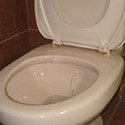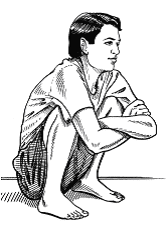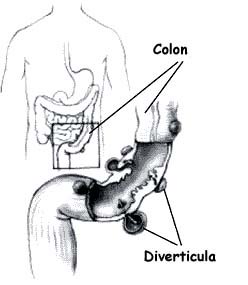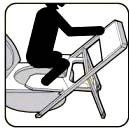|
Diverticulosis – Why Fewer Asians and Africans Get It...
Many people have diverticulosis but are not aware of it...
Like many other colon-related problems, diverticular disease is common in English-speaking, Western countries. But it is extremely rare in Asia and Africa. According to Medicinenet.com, "Diverticular disease is common in the Western world but is extremely rare in areas such as Asia and Africa."
The Wikipedia online encyclopedia website goes further by identifying these Western nations: "About 10% of the US population over the age of 40 and half over the age of 60 has diverticulosis. This disease is common in the US, England, Australia, Canada, and is uncommon in Asia and Africa."
The statistical data indicates that everyone (living in the West) would be affected by diverticulosis sooner or later:
Diverticulosis and Sitting Toilets  For 20 long years, the underlying cause of diverticulosis -- the use of sitting toilets -- had all along been confirmed by research.
For 20 long years, the underlying cause of diverticulosis -- the use of sitting toilets -- had all along been confirmed by research.
Dr B. A. Sikirov, the Israeli physician who did extensive clinical research on the
use of squatting to treat hemorrhoids in 1987,
had also looked into diverticulosis. This was what he found [Etiology and Pathogenesis of Diverticulosis Coli: A New Approach; Medical Hypotheses, May 1988; 26(1):17-20]:

SIDENOTE The mainstream doctors who are supposed to help those who are suffering are ignorant of, or refuse to acknowledge the connection between toilet posture and diverticular disease. As a result, the treatments for diverticular disease don't address the root cause, but on clearing up infection and inflammation, and minimizing complications. And when everything don't work out, there is always the surgical knife. For decades, and up till now, doctors and medical researchers have come up with theories and explanations for the high incidence of diverticulosis in the West. The most dominant (but unproven) theory is the high fiber theory...
SIDENOTE ========================================== Fiber from whole plants has been shown to have beneficial effects. So there's good reason to keep eating it. But it is not the main factor in diverticular disease. Rather than fiber, the introduction and proliferation of sitting toilets that is the key factor for the emergence of diverticulosis and other colon-related problems. Although the first modern (sitting) water closet was invented by John Harrington in 1596, it was in the mid 19th century (ie: 1850's onwards), at the beginning of the Industrial Revolution, that sitting toilets took root in England. It then spread to the other Western countries.
However the closest the medical establishment ever came to identifying the real cause of diverticulosis was the realisation that it has something to do with straining for bowel movements:
If the researchers had gone deeper, explored further, examined the data carefully, they would have know the truth about diverticulosis, and how it can be prevented. Again, quoting Dr Sikirov: 1) Colonic diverticulosis develops as a result of excessive straining at defecation due to habitual bowel emptying in a sitting posture. 2) The (squatting) defecation posture in underdeveloped nations. But that did not happen. Today, the porcelain throne remains entrenched in Western society; as a result, most Westerner adults have lost the ability to squat easily and comfortably. First taking root in England in the 19th century, the sitting toilet continues its relentless march. It is making huge inroads even in countries where people have traditionally been using squatting toilets. As long as sitting toilets are used, there would be -- in the words of Mayo Clinic -- a lot of "straining during bowel movements over many years." It really boils down to toileting posture...whether one sits or squats for waste elimination. By and large, the medical establishment do not want to talk about it. The companies that make the drugs and/or surgical equipment for treating diverticulosis and diverticulitis would rather not have you know that... is the no-cost, natural remedy and cure for diverticulosis and diverticulitis... 
But will people take heed and act, if they know? Many won't... One point though. If you desire to change, but have never used squatting toilets before, you might find it difficult to squat easily, as explained on this page about squatting facets. But you can regain the ability to squat again with some practice. This would then allow you to switch from sitting to squatting for waste elimination, using one of the options listed
here.

You can find out more about Nature Knows Best by visiting this page.
Have A Great Story About This Topic?Do you have a personal account about the topic discussed on this page? Please consider sharing it. You can be sure that many people in the world would love to read about and greatly benefit from your experience. It's easy to do. Just let your words flow. Thanks for sharing! What Other Visitors Have SaidClick below to see contributions from other visitors to this page...
Raised Toilet Seat for Elderly
my diverticulitis story Not rated yet
|
The Best Toilet Converter in The World Today!


Helping People All Over
The World Achieve
Good Health Through
Correct Toileting Posture
Watch video on the
origin and story of
the Sandun-Evaco
toilet converter
All about Life,
Hope and Truth...
FREE:
One of the most
astounding books
you will ever read
in your life!




 Diverticulosis occurs when the outer layer of the large intestine (colon) weakens and give way in many spots, and the inner lining bulges outwards in pouches or sacs. (It is like the inner tube that protrudes out through holes on the walls of a worn-out tire.)
Diverticulosis occurs when the outer layer of the large intestine (colon) weakens and give way in many spots, and the inner lining bulges outwards in pouches or sacs. (It is like the inner tube that protrudes out through holes on the walls of a worn-out tire.)







